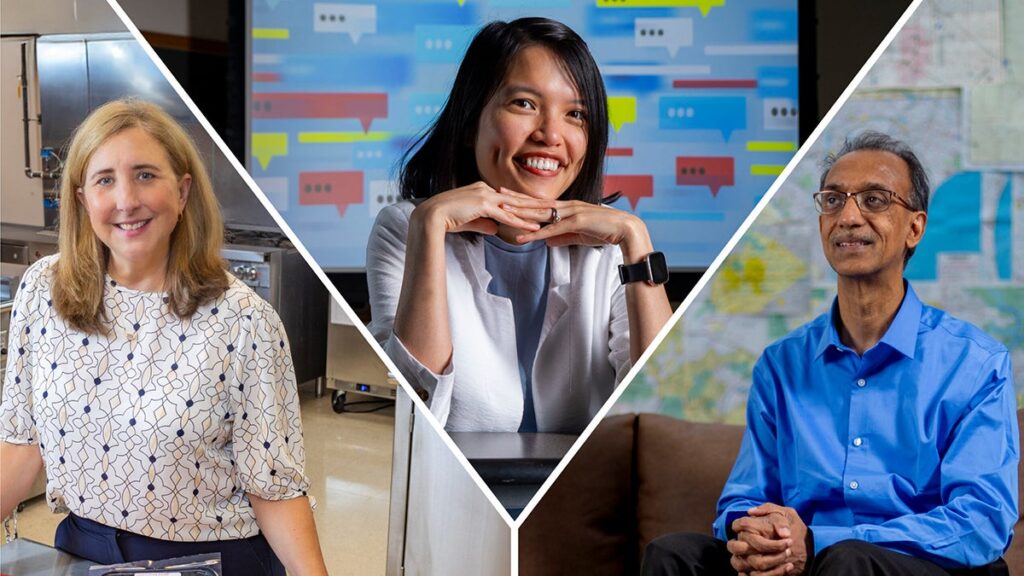Artificial intelligence allows users to build on existing knowledge and gain new insights. This is why it revolutionizes research in a variety of fields. Meet three UNC-Chapel Hill researchers who use AI in nutrition, transportation and education.
Creating a personalized food plan
Tate is collaboratively leading research aimed at developing algorithms to provide personalized nutritional plans tailored to the unique dietary needs of all. (Megan Mendenhall/UNC Research)
Imagine a future where you can customize your meals and perfectly match your personal unique makeup. It helps to prevent the effects of chronic and progressive diseases such as obesity, diabetes, and cardiovascular disease.
This vision is the driving force behind nutrition for precision health, powered by an all-US research program. This $170 million investment from the National Institute of Health’s Common Fund aims to explore how genetics, gut bacteria, the environment and lifestyle affect our response to food. What makes this initiative particularly innovative is the use of AI.
“For every intervention we tried, half of the people are successful, and half of the people aren’t. We are on average trying to move from the most effective to the individual,” explains Deborah Tate, professor of nutrition in global public health and interim director of the UNC Nutrition Research Institute. Tate is leading research with nutrition professor Elizabeth Mayer Davis.
The goal is to develop algorithms to examine weight, age, blood glucose and other health information to predict food regimens to achieve specific health goals, such as lowering blood pressure. These advancements offer an unprecedented opportunity to generate new data that provides insight into precision nutrition.
Safer road mapping

Srinivasan uses AI to help the North Carolina Department of Transportation identify the presence of guardrails and other objects that reduce the severity of car accidents. (Megan Mendenhall/UNC Research)
Researchers like Raghavan “Srini” Srinivasan, a senior transport research engineer at the UNC Highway Safety Research Center, play a key role in this process by studying driver behavior, analyzing traffic data, and how to develop solutions to prevent road crashes and injuries.
Many state agencies have information about roads, including lane count, width, traffic volume, shoulder and curve functions.
“But when we’re talking about roadsides across the shoulders, like in the presence of guardrails, poles or other objects, there’s a gap,” explains Srinivasan. “Many state agencies do not have any information about poles or other objects that are over the shoulder.”
Inserting guardrails will help prevent vehicles from moving far away from the road, but strategically placing utility poles in areas where runaway vehicles are unlikely to collide can reduce the severity of the accident.
Srinivasan and his colleagues at HSRC partnered with Renci, Carolina’s computing lab, to help identify these objects using AI. In the next phase of the project, the team is developing an AI model that can identify the exact coordinates of these objects, validated by a mapping technology called Lidar.
Improvement in science education

Nguyen’s work touches on a variety of AI-related applications and data. (Megan Mendenhall/UNC Research)
Ha Nguyen, an assistant professor at the UNC School of Education, focuses on the intersection of education and technology, particularly how students learn in science classes.
Nguyen is thinking about ways chatbots can help students identify with scientists and build their own scientific identity. In the current project, she trains chatbots to create more relevant and realistic answers using information from interviews with local residents and students, sustainability, the values they associate with their sense of place, and the effects of bad weather on these values.
Another strand of Nguyen’s work is to design AI technologies that help researchers analyze and understand data more effectively. The goal is to provide students with customized feedback and follow-up questions related to their performance.
“The level of teasing students’ thoughts and their reactions is really important,” says Nguyen. “But teachers don’t always have time to do that.”
Read more about AI in your research.



